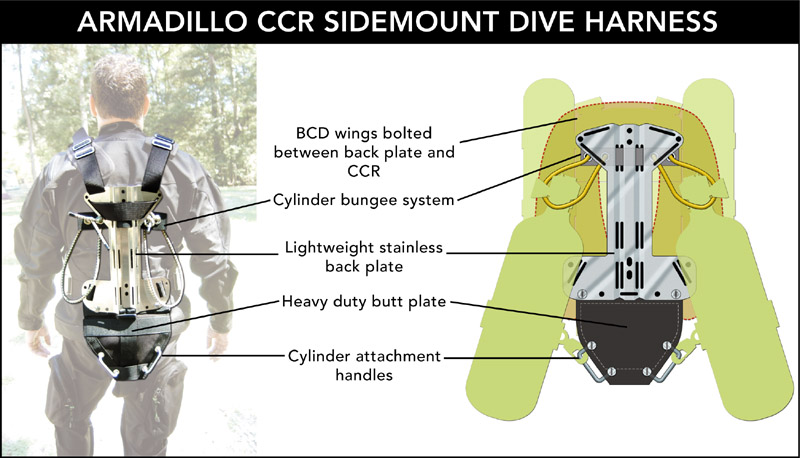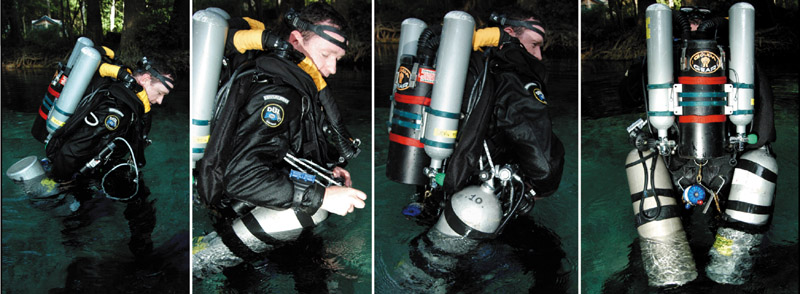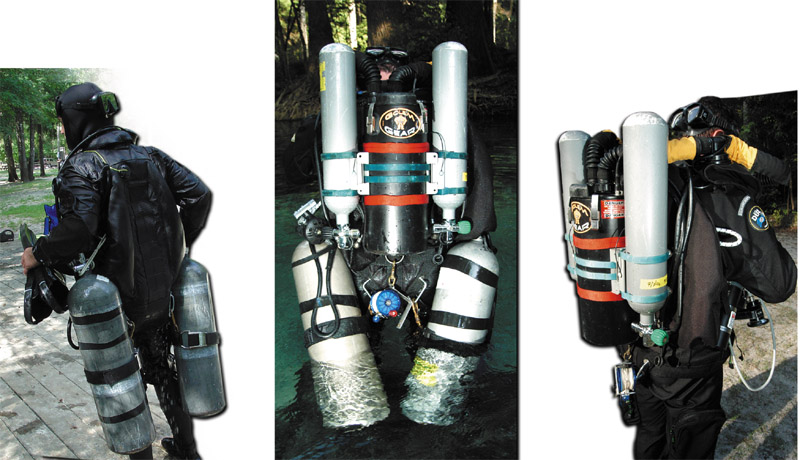|
| |
|
|
|
|
Text and Photography by Curt Bowen |
|
|
|
Following the rule of thirds for cave diving, or calculating the amount of decompression gas required to safely conduct extended range dives while using open circuit scuba was somewhat simple. Turn the dive at 2/3rd your starting pressure, bring an aluminum 80 of 50% and a 40 cu ft of oxygen, and that would get you through most standard extended range dives.
But now there is a new guy on the block who is using a system that allows him to push way past where open circuit used to restrict him. Closed circuit rebreathers are definitely the answer to extending what was once a dive that would require multiple cylinder stages, hundreds if not thousands of cubic feet of gas, and multiple set-up dives to explore the furthest reaches of the most famous cave systems or extreme deep wrecks. Now, we can dive three to five hours at any depth, mix our decompression gases by the best ppo2, and carry it all in two small 19 cu ft bottles.
|
|
|
|
|
 |
|
|
While these systems solved the required gas supplies, best mix calculations, and reduced decompression times, they opened up a whole new can of worms to be dealt with.
As long as everything on these sometimes complex systems works without a flaw, we are in dive heaven. But what if we should have to bail off our new-fangled miracle machine, and find ourselves in a place much further and deeper than we ever would on a normal open circuit dive? How do we save our pansy-assed Starbucks-coffee-drinking butts now? We must revert back to the old school of open circuit bailout.
With our backs cluttered with this specialized fancy carbon-dioxide-scrubbing, oxygen-monitoring, LED-illuminating machine that looks like it just came out of a mission from Mars movie. We find ourselves with no place to pack on those heavy primeval steel tubular things we used to call tanks, and brag that we had the biggest of, amongst other things.
|
|
|
| Bailout Stage Cylinder Attachment |
 |
| 1. Attach stage cylinder’s cam clip onto the sidemount butt plate handle. |
|
| 2. Retrieve the bungee and stretch it over and around the stage cylinder on/off valve. |
|
| 3. Allow the stage cylinder to rest under arm pit. Repeat the same process for the other stage. |
|
| 4. Once horizontal under water the bungee should pull the neck of each stage snug into the divers armpit. |
|
|
|
|
|
Yes, we can snap these 48-pound medieval tanks of torture onto our counterlung, dive-light, reel-cluttered chest, and attempt to swim through the cave or high current wreck like a child’s kite in the wind. It also brings on a whole new meaning for fitting through any restriction, such as a small opening like a ship’s cargo hold or the main tunnel in Wakulla Springs. Any hole less than the size of a small compact car now has become a major restriction. Don’t even think about reaching your dry suit inflator, or retrieving your backup decompression tables around those bulky tanks without first boning up on your yoga courses.
Open circuit sidemount diving is by far the most compact, streamlined method of diving, beyond free diving, that was ever created. It allows the diver to fit through restrictions barely higher than their chest, and glide through high flow caves and currents with the ease of an Olympic swimmer.
It would be only natural to marry the two ideologies of diving together into one complete system. Out of the two arose a unique piece of equipment that provides the diver with a streamlined method of carrying the required open circuit bailout gas without cluttering up their chest and restricting movement and access to vital rebreather life support equipment.
|
|
|
 |
The Evolution of the CCR Harness |
|
|
|
|
Adapting the basic bits and pieces used on an open circuit sidemount harness to the back-mounted rebreather harness, we have simply solved the problem. The diver can now easily attach two large bailout cylinders onto the special butt attachment location, and bungee its valves tight under their armpits. Moving these cylinders into this location provides the rebreather explorer the maximum streamlined configuration, and allows the diver full access to all equipment on his/her chest and waist. Tucking the cylinder valves up under the diver’s armpits also greatly reduces the amount of drag, and minimizes the potential for snag problems. This system also allows the diver to easily remove and attach the stage cylinders, if needed, in the case of an emergency such as a buddy’s rebreather failure.
Commercially available CCR sidemount systems are available through Golem Gear and Diverite.
www.golemgear.com
www.diverite.com
|
|
|
|
|
|
|
|
| |
|